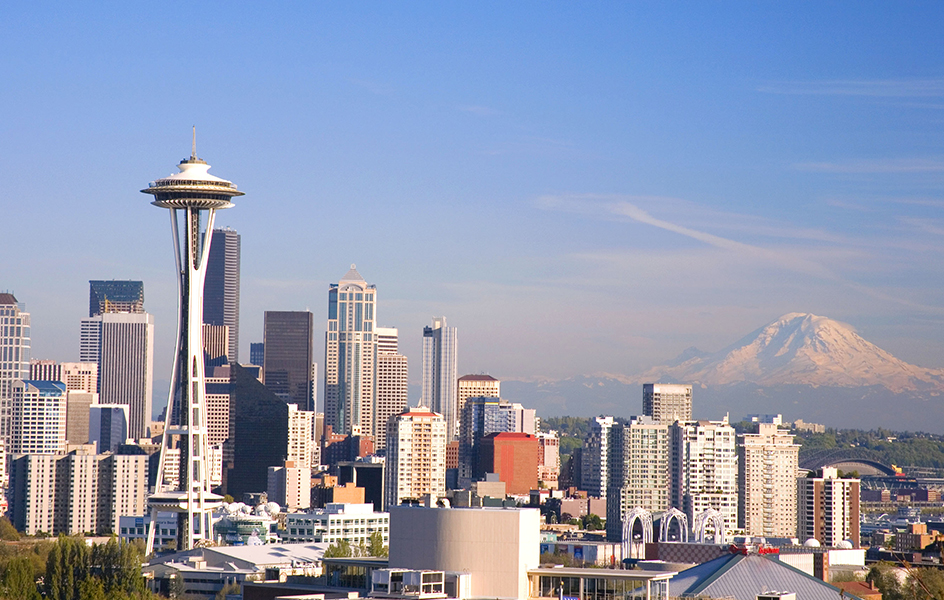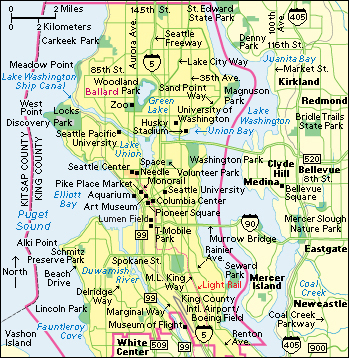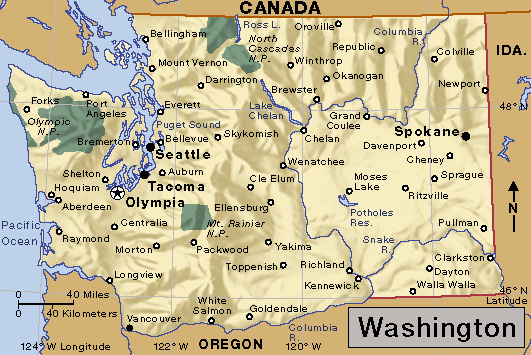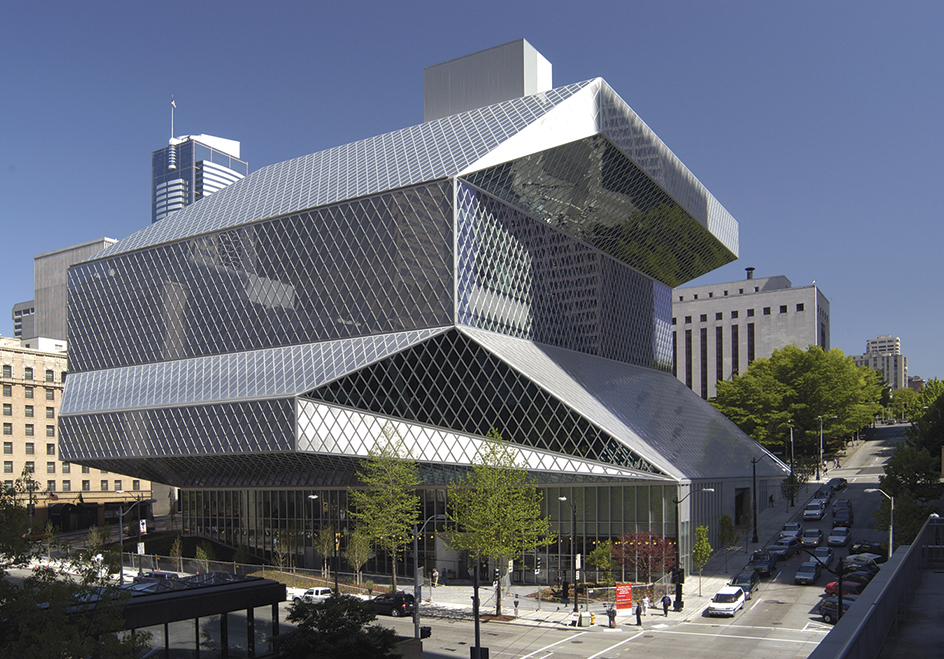Seattle is a beautiful city in Washington state with spectacular views of high mountains and sparkling coastal waters. It is Washington’s biggest city and the heart of a large metropolitan area. Seattle is also a manufacturing, trade, and transportation center for the Pacific Northwest. 
Seattle lies on the east shore of Puget Sound, an arm of the Pacific Ocean. A channel called the Strait of Juan de Fuca links Puget Sound with the ocean. Seattle was founded in 1852 by settlers from Illinois. They named the town for Sealth (also spelled Seatlh or Seattle), a leader of the Suquamish people who befriended them. The city grew as a center for producing lumber from Washington’s forests and shipping it to many markets. A variety of other economic activities also developed. In the 1900’s, the Seattle area became a center of aircraft and spacecraft manufacturing and other high-technology industries.
The city
The city of Seattle lies in King County. The downtown area extends east from Elliott Bay, an inlet of Puget Sound. So much water surrounds the downtown area that it seems like an island. In addition to Elliott Bay on the west, Lake Washington lies to the east and Lake Union and Union Bay to the north of the downtown area. During the most recent ice age, which ended about 11,500 years ago, glaciers carved out hills and valleys that today form the city’s setting. Seattle’s hills rise over 500 feet (150 meters) above sea level.

In the late 1800’s and early 1900’s, major engineering projects reshaped Seattle’s landscape. City engineers used high-pressure water jets to remove several hills, creating new flat land to allow expansion of the central business district. The soil from the hills was dumped into Elliott Bay or used to raise the level of low-lying areas called tide flats south of downtown. These areas, formerly covered with shallow water at high tide, became dry enough for industrial development. Today, the tide flats serve as Seattle’s chief manufacturing and shipping centers.

Floating bridges connect central Seattle with cities on the east side of Lake Washington. Ballard, a neighborhood northwest of downtown near the Lake Washington Ship Canal, has many residents of Scandinavian descent. Many Asian Americans live in the International District south of downtown.
Landmarks.
Seattle’s many hills provide striking views of the Cascade Mountains to the east and the Olympic Mountains to the west. The Cascades include famous Mount Rainier, which rises 14,410 feet (4,392 meters), about 60 miles (95 kilometers) southeast of Seattle. Visitors can also get good views of the region from the 76-story Columbia Center downtown and from the Space Needle, an observation tower that rises 605 feet (184 meters) north of downtown.

The Space Needle served as the centerpiece for a 1962 world’s fair called Century 21. Today, the Space Needle and other fair buildings make up a cultural complex called the Seattle Center. The complex includes several performing arts spaces, the Pacific Science Center and other museums, a sports arena, and an amusement park. A monorail built for the fair links the Seattle Center with downtown.
The Pioneer Square historical district includes many old brick buildings erected after a disastrous fire in 1889 destroyed most of Seattle’s business district. The Pike Place Market sells fresh fish and meat, local farm produce, and craftworks.
The metropolitan area
of Seattle, according to the United States Census Bureau, covers King, Pierce, and Snohomish counties. The Census Bureau calls it the Seattle-Tacoma-Bellevue metropolitan statistical area. Major cities in the area include Tacoma and Lakewood to the south of Seattle in Pierce county; Everett, Edmonds, and Marysville to the north of Seattle in Snohomish County; Bellevue and Redmond to the east in King County; and Federal Way, Renton, and Kent to the south, also in King County. The four-county region of King, Kitsap, Pierce, and Snohomish is often called the Central Puget Sound Region. Kitsap County is west of Seattle, across from Puget Sound. The Seattle-Bellevue-Kent metropolitan division consists of King County.
People
Ethnic groups.
About 60 percent of Seattle’s people are white. The city has many people of English, German, Irish, or Scandinavian ancestry. Black people account for about 7 percent of Seattle’s population, and Asians and Pacific Islanders make up about 15 percent. Native Americans make up about 1 percent of the population.
Housing.
Slightly more than half of Seattle’s housing consists of single-family homes. In the part of King County outside the city, single-family dwellings account for two-thirds of the housing. Suburbs with many elegant homes include Hunts Point, Bellevue, Mercer Island, and Newport Hills. Pleasant residential neighborhoods include Laurelhurst, Madison Park, Magnolia, Queen Anne, and Washington Park. Waterfront or hillside locations with views of the mountains or Puget Sound are among the most desirable residential areas. South Seattle and the southern suburb of White Center, on the other hand, have lower-priced housing.
Education.
A seven-member elected school board oversees Seattle Public Schools. The four-county Central Puget Sound Region includes dozens of other public school districts. The area also has hundreds of parochial and other private schools.
The University of Washington is the region’s largest institution of higher education. It is also a major research center. Seattle Pacific University in Seattle, the University of Puget Sound in Tacoma, and a number of smaller colleges and universities also serve the region.
Social problems
of Seattle are similar to those of other large urban areas. Crime, much of it associated with drug abuse, is a major problem. Poverty and rapidly rising housing costs have contributed to a problem of homelessness in the city. In the 1960’s, the Seattle area pioneered in water pollution control to protect the water quality of Lake Washington and Puget Sound. As a result, water quality has greatly improved in the area. Air pollution, however, is a problem.
Cultural life
The Seattle area has a rich artistic tradition and offers a variety of cultural and recreational activities. Within an hour or two of driving time, residents can reach the Cascade or Olympic mountains, or the Pacific Ocean.
The arts.
The Seattle Symphony, Seattle Opera, Seattle Repertory Theatre, and Pacific Northwest Ballet are among the region’s largest artistic organizations. Seattle has a number of professional theater companies.
Some important artistic movements have developed in Seattle. For example, the Northwest School of painters, led by Morris Graves and Mark Tobey, created an elegant, Asian-influenced style of modern painting in Seattle during the 1930’s and 1940’s. In the 1990’s, Seattle became the birthplace of a forceful style of rock music called grunge, which featured driving guitar chords.
Museums and libraries.
The Seattle Art Museum divides its collection between two buildings. The larger of the two, in downtown Seattle, was designed by the American architect Robert Venturi. The other is the Seattle Asian Art Museum in Volunteer Park. The Seattle Art Museum also operates the 9-acre (3.6-hectare) Olympic Sculpture Park along Elliott Bay downtown. The Bellevue and Tacoma art museums also present major art exhibitions. Other Seattle museums include the Museum of Flight at Boeing Field (officially called King County International Airport), the Burke Museum of Natural History and Culture at the University of Washington, and the Museum of History & Industry. The Northwest African American Museum features exhibits on the region’s early Black settlers. The Museum of Pop Culture (formerly the Experience Music Project) is in a building designed by the American architect Frank Gehry. The museum features interactive exhibits that offer visitors an opportunity to make their own music. In the same building is the Science Fiction and Fantasy Hall of Fame, devoted to science-fiction literature and films.
The University of Washington has important library collections for scholars specializing in Far Eastern studies, Russian studies, and health sciences. Both the city of Seattle and King County maintain library systems with branches throughout the city and county. Seattle’s Central Library occupies a full block in downtown Seattle. The striking glass-and-steel building was designed by the Dutch architect Rem Koolhaas.

Recreation.
The city of Seattle and the Central Puget Sound Region offer outstanding opportunities for outdoor recreation and leisure activities. The Seattle area has a mild climate, with cool summers and warm winters. The climate leads people to participate in outdoor activities the year around. Sailing, windsurfing, running, skateboarding, and biking are some of the most popular activities. Nearby outdoor recreation areas include three national parks—Mount Rainier, Olympic, and North Cascades.
Seattle’s professional sports teams include the Seattle Mariners baseball team of the American League, the Seattle Seahawks of the National Football League, the Seattle Kraken of the National Hockey League, the Seattle Storm of the Women’s National Basketball Association, and Seattle Sounders FC of Major League Soccer. Other popular spectator sports include college football games at the University of Washington and hydroplane races on Lake Washington during the annual Seattle Seafair in July and August. These races feature high-speed motorboats that skim across the water.
The city’s park system includes hundreds of parks and other recreation areas. Discovery, Magnuson, Seward, and Lincoln parks have large areas of shoreline. Woodland Park is the site of the Woodland Park Zoo and the Woodland Park Rose garden. The Woodland Park Zoo and Tacoma’s Point Defiance Zoo & Aquarium are highly regarded for providing natural habitats for animals. The Woodland Park Rose Garden is one of the country’s test gardens for new varieties of roses. The Seattle Aquarium has an underwater viewing dome for observing the marine life of Puget Sound.
Economy
The Seattle area is a center for service industries. It is also a manufacturing and shipping region.
Service industries.
The Seattle area has long been a major trade, technology, and health care center for the Pacific Northwest. Tech companies, from software developers to online retailers, are major employers. Seattle’s extensive health care facilities draw many people with specialized needs. A leading medical research center, the Fred Hutchinson Cancer Center, is in the city.
Other important service industries include government and military activities. United States Navy facilities are important to the economy of Kitsap County. Army and Air Force bases are major employers in Pierce County.
Manufacturing.
The Seattle area’s major manufactured products include aircraft and software and other computer supplies. The Boeing Company, a leading maker of commercial airplanes and spacecraft, ranks as the region’s largest employer. Boeing has several assembly and research facilities in King and Snohomish counties. Numerous high-technology firms operate in the northeast suburb of Redmond. They include Microsoft Corporation, a computer software company; and the U.S. headquarters of Nintendo, a Japanese producer of video games.
Transportation and communication.
The Central Puget Sound Region serves as the transportation hub of the Pacific Northwest area. Automobile ferries shuttle commuters and tourists across Puget Sound. The Seattle-Tacoma International Airport, often called Sea-Tac, handles domestic and international flights. Busy ports at Seattle and Tacoma are centers for goods shipped between the United States and Asia. A light rail line links Seattle with Tukwila and Sea-Tac Airport. Commuter rail lines also serve Seattle and a number of area communities.
Seattle has a daily newspaper, The Seattle Times. Suburban and specialty newspapers are also published in the area.
Government
Seattle has a mayor-council form of government. The people elect the mayor and the nine City Council members to four-year terms. The mayor is responsible for the operation of city departments and submits an annual budget for them to the City Council. City elections are nonpartisan—that is, candidates are listed on the ballot with no indication of their political party.
About one-third of the people of the Central Puget Sound Region live in unincorporated areas. These areas have no city governments, so county governments are their chief source of government services. Metro, a municipal corporation that handled sewage treatment and public transportation throughout King County, became part of the county’s government in 1994.
History
Early settlement.
Many Native American tribes lived in the Seattle area before white settlers arrived. They included Duwamish, Snohomish, Suquamish, and other subdivisions of the Salish group. In 1851, settlers from Illinois led by Arthur A. Denny founded a town on Alki Point, a Puget Sound beach. The settlement was in the present-day neighborhood called West Seattle. In 1852, most of the pioneers moved to the east side of Elliott Bay, at the present site of downtown Seattle. Henry Yesler, a lumberman, built a sawmill there the next year. Seattle soon became a center for making lumber from wood of Washington’s forests and shipping it to boom towns of California, where gold had been discovered in 1848. Lumber became the basis of the local economy, and the making of paper grew in importance. Seattle received a city charter in 1869. The population reached about 1,000 by 1870.
Railroads and growth.
The Puget Sound region’s first rail link with the eastern United States was completed in 1883, when the Northern Pacific Railroad began service to Tacoma. In 1893, the Great Northern Railroad arrived in Seattle. The railroads brought settlers and opened national markets for the area’s natural resources. The new markets led to massive expansions of the area’s lumber and paper industries. Fire destroyed most of Seattle’s business district in 1889. Nevertheless, the city’s population grew to about 43,000 by 1890.
Economic expansion.
Lumber milling remained the Seattle area’s top economic activity until the early 1900’s. But the area began to develop a more varied economy. The Klondike and Alaska gold rush of 1897 and 1898 brought thousands of settlers to the Puget Sound region, which was on the route to the gold-mining areas. Seattle’s population soared to about 237,000 by 1910. The ports at Seattle and Tacoma grew into centers of international shipping after the opening of the Panama Canal in 1914. Agriculture and fishing, particularly salmon fishing, also increased in importance. In 1916, William Boeing started the Boeing Company, which soon became a leading aircraft maker.
After the United States entered World War I in 1917, Seattle began producing defense materials. The aircraft, lumber, and shipping industries flourished. Workers flocked to the city, and labor unions gained strength. After the war ended in 1918, the unions feared that they would lose ground because defense industries would need fewer workers. To protest the power of industry management, over 60,000 workers staged a five-day strike in February 1919. The strike, called the “Seattle Revolution of 1919,” was the nation’s first general strike.
Seattle also thrived during World War II (1939-1945). The aircraft industry boomed, and several shipbuilding companies were established. The industrial surge attracted many more newcomers to the city. The population rose from 368,000 in 1940 to more than 467,000 in 1950. By 1960, Seattle had 557,000 people.
In 1962, the Century 21 world’s fair helped promote tourism in Seattle. The fairgrounds and buildings, now called Seattle Center, are still a year-round civic and tourist complex.
In Seattle, as in other U.S. cities, large numbers of people moved from the central city to suburbs in the mid-to-late 1900’s. By 1980, the city’s population had dropped to about 494,000. It increased during the 1980’s, however, reaching 516,000 by 1990.
In the late 1900’s, a series of ups and downs in the aircraft industry, with resulting swings in employment, led to efforts to add variety to the economy. The efforts helped bring an increase in service industries, including tourism. In the 1980’s and 1990’s, a boom in computer-related and Internet businesses, led by the Microsoft Corporation, drew many high-technology workers to the area. The opening of the Washington State Convention Center (now called the Seattle Convention Center) in Seattle in 1988 and the Meydenbauer Center in Bellevue in 1993 attracted more convention business to the region.
The early 2000’s.
In February 2001, a powerful earthquake caused extensive property damage in the area. In mid-2001, the Boeing Company moved its headquarters from Seattle to Chicago. Boeing remained a large employer in the Seattle area.
The internet retail company Amazon, founded in Bellevue, a suburb of Seattle, in the 1990’s, became one of the region’s leading employers during the early 2000’s. The company established headquarters in Seattle’s Denny Triangle neighborhood in 2015.
Workers began demolishing the Alaskan Way Viaduct—an aging double-deck freeway—in 2011. Construction then began on a tunnel under the Seattle waterfront to replace the viaduct. The project also included the development of pedestrian spaces along Elliott Bay. The State Route 99 Tunnel (known as the SR 99 Tunnel) opened in 2019.
